Have you ever seen a chicken that looks like it’s wearing a coat of many colors? If you’ve stumbled across a bird with feathers in various shades and patterns, you might have met a Rainbow Chicken! As a backyard chicken enthusiast for over 5 years, I’ve raised several of these beautiful birds, and lemme tell you – they’re as practical as they are pretty.
Rainbow Chickens, also known as Dixie Rainbow Chickens, are a unique hybrid breed that combines the best of several chicken varieties These birds stand out in any flock thanks to their distinctive and varied plumage patterns.
What makes them special isn’t just their looks – it’s their versatility. These birds are what we call “dual-purpose,” meaning they’re great for both egg production and meat. This makes them super popular among backyard chicken keepers who want the best of both worlds.
Origins and Background
The Rainbow Chicken is a relatively modern hybrid breed developed in the United States. Unlike heritage breeds with centuries of history these colorful birds are the result of selective crossbreeding aimed at creating a chicken with specific desirable traits.
While they haven’t yet received official recognition from the American Poultry Association, their popularity continues to grow among backyard flock owners and small-scale farmers. Their hybrid origin contributes to their vigor and adaptability, making them suitable for various environments.
Appearance: True to Their Name
The name “Rainbow” isn’t just a cute marketing term – these chickens truly deserve this colorful moniker! Here’s what makes their appearance so special:
- Feather Colors: Predominantly found in tans and browns, often with speckled patterns
- Color Variations: Can also appear in white, black, or gray feathers
- Unique Trait: No two Rainbow chickens look exactly alike!
- Facial Features: Bright red combs, wattles, and earlobes
- Beak Color: Typically pale orange
- Legs and Feet: Yellow-orange
Their body type is plump with an upright tail, completing their distinctive appearance I’ve had four of these beauties in my backyard flock, and each one looked different from the others – like having a collection of unique artwork in my coop!
Size and Weight
Rainbow Chickens are medium to large-sized birds. They grow surprisingly fast, reaching their full adult size in just 12-13 weeks. This rapid growth rate is one of the traits that makes them excellent meat birds.
Adult weights typically fall within these ranges:
- Roosters: 7-8 pounds (3.2-3.6 kg)
- Hens: 5-6 pounds (2.3-2.7 kg)
Their height usually ranges between 8 and 14 inches tall when fully grown.
Temperament and Behavior
In my experience raising Rainbow Chickens, I’ve found their personalities to be as appealing as their colorful feathers. Here’s what you can expect from these birds:
- Generally Friendly: Most are sweet and affectionate with their keepers
- Confident: They tend to strut around with pride and confidence
- Social: They enjoy human interaction and get along well with other chickens
- Family-Friendly: Good with older children
- Territorial: Can become protective during mating, nesting, and laying seasons
- Vocal: While not the loudest breed, they do like to “chat” and express themselves
One of my Rainbow hens, Sparkle, would follow me around the yard whenever I was gardening, always curious about what I was doing. She’d even let me pet her while she supervised my work!
Egg Production
For many backyard chicken keepers, egg production is a top priority. Rainbow Chickens don’t disappoint in this department. Here’s what to expect:
- Average Production: 4-5 eggs per week
- Annual Output: 200-250 eggs per year
- Egg Color: Brown
- Egg Size: Medium
- Starting Age: Begin laying at 20-24 weeks (a bit later than some breeds)
One thing I’ve noticed with my Rainbow hens is that they continue laying pretty consistently even during temperature changes. Their hardiness means you’ll get eggs during both cold and hot seasons, which is def a plus!
Broodiness and Mothering
Rainbow Chickens show a high tendency toward broodiness. This means they often want to sit on and hatch eggs, which can be either a benefit or a challenge depending on your goals:
- Pros of Broodiness: Natural reproduction, good mothers to chicks
- Cons of Broodiness: Egg production decreases during broody periods
If you’re primarily raising these birds for consistent egg production, you might need strategies to discourage broodiness. However, if you’re interested in hatching chicks naturally, their maternal instincts are a valuable trait.
Meat Production
As dual-purpose birds, Rainbow Chickens are also raised for their meat. Their rapid growth rate means they reach market weight relatively quickly:
- Growth Rate: Reach full size in 12-13 weeks
- Meat Quality: Flavorful and well-proportioned
- Processing Age: Often processed around 10-11 weeks when they weigh 4.5-5 pounds
While they don’t grow quite as quickly as dedicated meat breeds like Cornish Cross, they offer the advantage of being good egg layers as well.
Health and Hardiness
Rainbow Chickens are generally hardy birds, but like all chicken breeds, they have some health considerations to keep in mind:
Common Health Issues:
- Salmonellosis: Like all chickens, they can carry salmonella bacteria
- Ascites Syndrome: Due to their rapid growth, they may develop heart problems
- Leg Development Issues: Their fast growth can sometimes lead to leg weakness
Hardiness:
- Cold Weather: Quite resistant to cold temperatures
- Heat Tolerance: Adaptable to warm climates as well
- Disease Resistance: Generally good immune systems thanks to hybrid vigor
To keep your Rainbow Chickens healthy, provide a clean environment, appropriate nutrition, and regular health checks. Their average lifespan is typically 6-8 years with proper care.
Care Requirements
Taking care of Rainbow Chickens isn’t too difficult, but there are some specific needs to meet:
Housing:
- Coop Space: At least 4 square feet per bird
- Run Area: 8-10 square feet per bird
- Nest Boxes: One 14x14x20-inch box for every 4 hens
- Enrichment: Dust baths, mirrors, and other stimulating elements
Feeding:
- Chicks (0-4 weeks): Starter feed with 22-24% protein
- Growing Birds: Finisher feed with 18-19% protein
- Adult Layers: Layer feed with 15-17% protein plus calcium supplements
- Fresh Water: Always available and clean
Temperature:
- Ideal Range: 65-75°F (18-24°C)
- Cold Weather: May need supplemental heat during extreme cold
- Hot Weather: Require shade and ventilation during heat waves
I’ve found that my Rainbow Chickens appreciate a deep litter system in their coop during winter months. It helps generate some natural warmth through decomposition and gives them something to scratch around in when they don’t want to go outside in the cold.
Cost and Availability
If you’re thinking about adding Rainbow Chickens to your flock, here’s what you can expect to pay:
- Straight Run Chicks: $3-$4 each
- Sexed Female Chicks: $4-$7 each
- Sexed Male Chicks: $2-$5 each
- Adult Birds: $10-$50 depending on age, color, and quality
These birds are primarily available through specialized hatcheries. Some popular suppliers include Hoover’s Hatchery, where Rainbow chickens are priced between $4.12-$6.42 depending on quantity and whether you purchase straight run, male, or female chicks.
Pros and Cons of Rainbow Chickens
Pros:
- Beautiful, varied plumage
- Dual-purpose for both eggs and meat
- Friendly temperament
- Good egg production
- Hardy in various climates
- Fast growth rate
Cons:
- Not a standardized breed (appearance varies)
- Start laying a bit later than some breeds
- May develop leg problems due to rapid growth
- Can be territorial during certain seasons
- Egg production drops with age more quickly than some specialized laying breeds
Comparison to Other Popular Breeds
How do Rainbow Chickens stack up against other popular backyard breeds?
vs. Rhode Island Reds:
- Similar egg production
- Rainbow Chickens grow faster
- Rhode Island Reds have more consistent appearance
vs. Buff Orpingtons:
- Both have friendly temperaments
- Orpingtons are generally larger
- Rainbow Chickens typically lay more eggs
vs. Cornish Cross:
- Cornish Cross grow faster for meat
- Rainbow Chickens lay more eggs
- Rainbow Chickens have longer lifespans
Are Rainbow Chickens Right for You?
Rainbow Chickens might be perfect for your backyard flock if:
- You want both eggs and meat from the same birds
- You enjoy having colorful, unique-looking chickens
- You’re looking for birds with friendly temperaments
- You have families with children who will appreciate their sociable nature
- You want birds that are relatively low-maintenance
I’ve found them to be wonderful additions to my mixed flock, offering a good balance of practicality and beauty. My kids especially love identifying “their” chicken among the flock since each one looks so different!
Final Thoughts
Rainbow Chickens (or Dixie Rainbows) truly are one of the most visually interesting breeds you can add to your backyard flock. Their combination of good egg production, meat quality, and friendly temperament makes them an excellent choice for beginners and experienced chicken keepers alike.
While they may not be as specialized as dedicated egg or meat breeds, their versatility more than makes up for it. Plus, who doesn’t want a living rainbow strutting around their backyard?
Have you raised Rainbow Chickens? I’d love to hear about your experiences in the comments below!
Frequently Asked Questions
Q: Do Rainbow Chickens actually lay colorful eggs?
A: Despite their colorful name, Rainbow Chickens typically lay brown eggs, not multi-colored ones. If you want colorful eggs, consider breeds like Easter Eggers or Olive Eggers.
Q: How noisy are Rainbow Chickens?
A: They have moderate to occasionally loud noise levels. Hens are particularly vocal when laying eggs, and roosters will crow, especially in the morning.
Q: Are Rainbow Chickens good for beginners?
A: Yes! Their friendly nature, hardiness, and dual-purpose utility make them excellent birds for those new to chicken keeping.
Q: How many Rainbow Chickens should I get?
A: Chickens are social creatures, so a minimum of three is recommended. For a family of four, 4-6 hens would provide a good supply of eggs.
Q: Can Rainbow Chickens free-range?
A: Absolutely! They are good foragers and enjoy roaming and finding bugs and vegetation to supplement their diet.

What do Dixie Rainbow Chickens look like? (Identification)
One awesome characteristic of rainbow dixie chickens is they often look totally different from each other! In fact, they’re classified as a “rainbow” because there’s no set look to them – each chicken has the most unique feather pattern. Their varied feather patterns and color patterns provide some of the most vibrant plumage and tail feathers. I experienced birds with both earthy colors and others with vibrant colors. They were the most unique chickens I raised, and are currently still my top choice (right next to Barred Rocks!).
The standard pattern of a Dixie Rainbow is tan/brown and speckles, somewhat like this picture below.
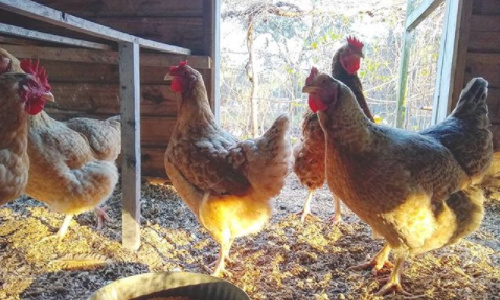
But the beautiful characteristic of Dixie Rainbows is that every now and then you get a wild card. From our last flock, we got 2 brown hens, 2 more standard looking hens, 1 beautiful speckled roo and the head-honcho and first-hatched the snow-white roo!
Some chicks may also have winged eyeliner or a small flick of black stretching from the corner of their eyes.
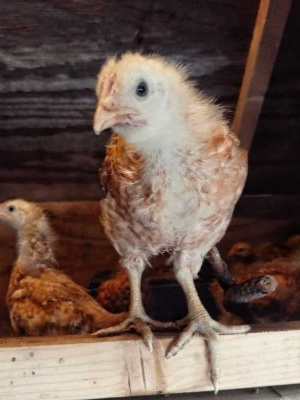
These hybrid breed chickens are full of great personalities. Full of life, they’ll strut around the yard like they’re the best breed there is (they’re pretty close to it!).
You’ll find the hens are wonderful mothers when they go broody, committing to the brood and hatching their young to success. Watch out, though! A broody hen might give you a good peck if she’s a committed mama, which is almost always. Mainly, though, you’ll experience a sweet bird.
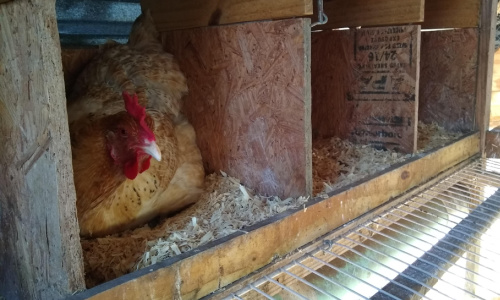
In fact, even when you incubate eggs they prove their resilience. The few eggs that had trouble pipping or zipping have been fighters! It’s amazing to watch a little day-old chick decide that today is a day to live, not die. We, of course, assist when appropriate!
I mean, just look at this strong little chick!
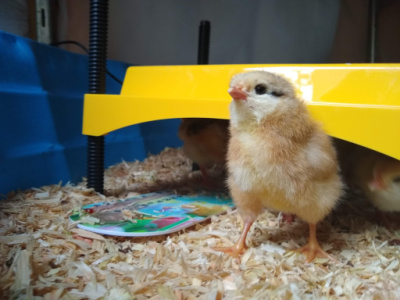
As for the roosters, in my experience, I haven’t had an aggressive Dixie Rainbow rooster yet. Large? Yep. You betcha. A little bit slow to learn? Yes, I’ll have to admit.
But they’re good roosters and you don’t have to worry about being attacked. They’ll watch over the hens and they’re beautiful. I haven’t had a bad looking Rainbow Roo’ yet!
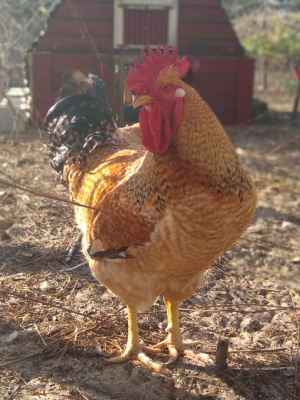
Since Dixie Rainbows are a dual-purpose breed, they grow quicker than the average. If you’re raising rainbows as meat birds, you can expect them to reach market weight around 12-13 weeks and will be 6-8 pounds of weight at maturity. BIG BIRD. This is the perfect weight for a broiler, or fryer.
At 12-13 weeks your flock will have full combs and wattles and your roosters will start to cock-a-doodle-doo. This is my most recent flock, and yes, they are ALL Dixie Rainbows – full bred. The flock in the photo below are roughly 13 weeks old!
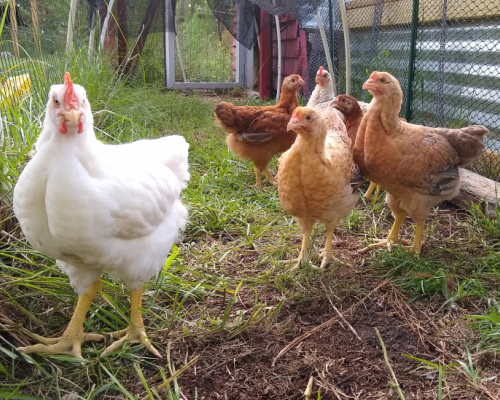
Dual purpose birds don’t typically take longer than 18 weeks to reach market weight – and by that time you’ll have actual big birds on hand. By 20-24 weeks of age or older, you’ll need to plan to utilize your chickens as roasters or stewing chickens. For more information on the difference in sizes when raising, culling and cooking chickens you can read this informative article from The Kitchn.
Although I have not raised Cornish Cross chickens, I didn’t love what I read about them. Cornish Cross chickens are probably one of the most stereotypical, generic meat chickens. It’s what you often find in factory-farmed setups, but I do know smaller homesteaders who choose to raise Cornish Crosses.
The reason I chose against it is that they’re bred to grow at a very fast growth rate, meaning at some point they’ll likely not even be able to support their own weight. Cornish Cross chickens are a good breed if you are good at sticking to a schedule, as they’ll need to be promptly culled once they’ve become a mature chicken. At their mature weight, Cornish Cross chickens can grow to 8 lbs in as little as 8 weeks.
I’ve also read not to raise them in the summer season as they are not heat-tolerant birds.
Egg production might be one of the most important characteristics to look at in a chicken for most people. It is absolutely possible to find a breed of chicken that produces both quality meat and provides a plethora of large eggs throughout the year. Enter: dual purpose, or “hybrid”, chicken breeds *cough…the dixies!*
The rainbow layer chicken lays a medium-large brown egg, so if you’re looking for different egg colors then Dixies aren’t for you. These yummy brown eggs are often more towards the larger size and I’ve even gotten a few double yolks!
If you’d prefer a flock that lays a variety of eggs, you’ll need a variety of birds. Luckily, Dixie Rainbow chickens get along well with other breeds. Try pairing them with Buff Orpingtons, who are some of the best egg producers. For colored eggs, choose an Easter Egger breed that lays blue eggs! Easter eggers are a blue egg layer breed and, while they lay beautiful eggs, they’re not the best choice for a meat chicken as they stay pretty small.
I’ve raised Rhode Island Red chickens who are also great layers that lay light chocolate brown fresh eggs. Different breeds bring in a slightly different egg color ranging from the standard white egg, blue eggs to dark brown eggs to the Olive Egger, giving you olive green eggs!
The options are endless, really. No matter if your chickens lay lots of eggs that are colored or not, they’re all the same on the inside regardless of the shell color. Yummy, fresh eggs with rich yellow-orange yolks!
On average, Dixie hens are great egg producers, laying around 225-250 eggs a year. Keep in mind, to receive optimal egg production you should always supply your hens with a feed of at least 16-17% protein along with unlimited access to clean water. Your local feed store, Tractor Supply or Rural King should have this. Dixies are a large size, fast growing bird.
If you supply them with proper care, a balanced diet with adequate protein and clean drinking water, they’ll supply you with beautiful, farm-fresh eggs.
You can expect these hybrid hens to start laying at the end of the spectrum of 20-24 weeks.
Jersey Giant hens are efficient egg producers and hearty meat chickens. Among the largest breeds, Jersey Giants are a great dual-purpose chicken option for your homestead if you have the space. Barred Rocks and White Rocks are also an acceptable dual-purpose breed of chicken, better suited for a smaller homestead than Jersey Giants.
I’ve never had a problem in the winter with my hens not laying. In fact, optimal egg production for my Dixies were always in the cooler months. I will say, though, that the summer of 2020 was particularly hot and their laying significantly slowed down.
From my small flock of 7 hens, I usually received 4-5 eggs a week. In the heat of the 2020 summer with constant heat advisories, I was lucky to get 4 eggs a week. This wasn’t the norm, though.
I live in Eastern Kentucky now and look forward to raising Dixie Rainbows in this cooler climate, eventually. I anticipate they’ll do well as they’re large, hardy birds – similar in shape to Barred Rocks or a Buff Orpington.
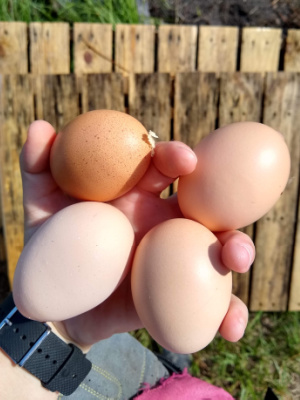
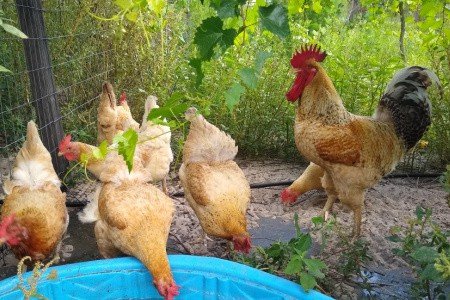
For folks who live in more southern states, you don’t have to expect a bad molt from Dixie Rainbows. Here’s a picture of my flock in the winter of 2019. Our winters in Florida are quite mild and I’ve never experienced a real molt. This year my Dixies molted more than they ever have.
I live in West Central Florida. That means my chickens must be able to endure some intense heat and humidity. My Dixie Rainbow Chickens have done wonderfully in the heat of the summer. Their egg production dropped off slightly, but that’s expected.
In the winter of 2021, the temperatures dipped down pretty low here. Although it never got cold enough, for long enough, for me to worry about keeping my chickens warm in winter weather. The Dixies still did great in the low 30’s. These chickens are great adjusters!
The beginner’s guide to dixie rainbow chickens.
I originally learned of the Dixie Rainbow chicken breed by reading on the Backyardchickens.com website about hybrid breed chickens. I knew I wanted a laying flock and a flock for meat production, so why not maintain small backyard flock of 6-7 hens that could do both?
If Dixie Rainbows were as great of a hybrid (dual-purpose bird) as I’d read, they would be the best meat chicken for my little homestead at the time. And if they were great layers, as I’d read, then eventually I could just raise that breed.
Well, that’s exactly what ended up happening! The best part of choosing a hybrid breed chicken is it allows you to have the best of both worlds, without having too many chickens running around.
